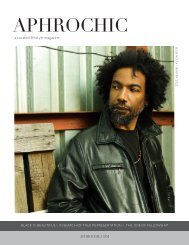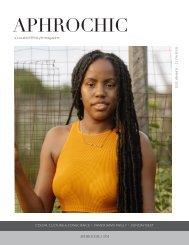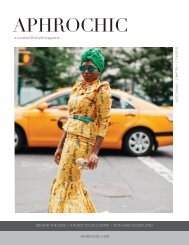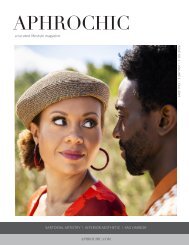AphroChic Magazine: Issue No. 11
You also want an ePaper? Increase the reach of your titles
YUMPU automatically turns print PDFs into web optimized ePapers that Google loves.
Reference<br />
The African Diaspora is a reality and<br />
a fact. Hundreds of years ago, millions of<br />
people were forcibly removed from the African<br />
continent and flung across oceans, forced to<br />
labor and suffer the inhumanity of those who<br />
purchased, traded and used them like objects<br />
or animals. In the centuries since, the descendants<br />
of the dispersed have formed new<br />
cultures that have themselves grown to impact<br />
and shape the world — including the continent<br />
of their initial dispersion — not by conquest but<br />
by the power of their content. These cultures<br />
are connected by their place of origin, their<br />
shared and similar histories, and their constant<br />
influence and reliance on one another.<br />
The African Diaspora is also a story and<br />
a tool. And as such, how we choose to envision<br />
it narratively will have the most crucial impact<br />
on how we perceive its reality and how effective<br />
a use we make of its utility. As with so many<br />
things, the shape of Diaspora is determined<br />
largely by how we choose to see it.<br />
In the previous segment of this series, we<br />
encountered several frameworks developed<br />
by scholars of different fields and times. Some<br />
have been specific to the African Diaspora,<br />
while others have sought to define diasporas<br />
as a whole. Some begin with the trans-Atlantic<br />
slave trade and some point to a distant<br />
moment in antiquity as the point where our<br />
Diaspora began. And while some upheld the<br />
idea of the “underlying African self” classifying<br />
all members of the Diaspora as essentially the<br />
same, others emphasized difference and the<br />
spaces between us. Yet despite these differences,<br />
each of them is a story of us, a lens, lending<br />
a specific shape to how we see our Diaspora,<br />
our communities and ourselves. And like any<br />
tool, these stories must be evaluated: How well<br />
do they work? Do they help or harm? And what<br />
direction do they point us in as we follow them<br />
forward? So, as not to be overwhelmed by the<br />
sheer multitude of current diaspora models,<br />
this series will confine itself to two which have<br />
been most impactful for the African Diaspora<br />
particularly, the Triadic model of Joseph<br />
Harris’ and Paul Gilroy’s Black Atlantic.<br />
The Triadic / Harris Model<br />
Introduced by Jospeh Harris, one of<br />
two scholars credited with first coining the<br />
phrase “African Diaspora,” the Triadic model<br />
is compact but robust. In concept it mirrors,<br />
if not directly derives from, Eric Williams’<br />
outline of the “Triangular Trade” in enslaved<br />
Africans, raw materials and finished products<br />
that ran between the three sites of Europe,<br />
Africa and the many colonies of the “New<br />
World.” Like Williams, Harris proposes an understanding<br />
of the global complex of historical<br />
and cultural interactions that make up the<br />
Diaspora as a relationship between just three<br />
significant points: The continent of Africa;<br />
those who were dispersed (and their descendants);<br />
and the lands to which they respectively<br />
went. Between these few poles, however,<br />
Harris encapsulates a myriad of relationships<br />
and historical points. Outlined in his work,<br />
The Dynamics of the Global African Diaspora,<br />
part of the larger work, The African Diaspora,<br />
edited by Alusine Jalloh and Stephen Maizlish,<br />
Harris immediately notes the tangible<br />
impact of diasporas as entities that, “develop<br />
and reinforce images and ideas about [the<br />
dispersed] and their original homelands, as<br />
well as [affecting] the economies, politics, and<br />
social dynamics of both the homeland and the<br />
host country or area.”<br />
In envisioning the history of our diaspora,<br />
Harris divides the timeline between what he<br />
terms the “historical diaspora,” made up of the<br />
voluntary as well as involuntary movements<br />
of Africans prior to the start of the trans-Atlantic<br />
slave trade and the “modern diaspora,”<br />
which is essentially everything that came after.<br />
Though he makes the distinction specifically to<br />
call out the extent to which African movement<br />
in antiquity was volitional, he nevertheless<br />
points to slave trades in both periods (specifically<br />
the trans-Saharan trade which predates<br />
the trans-Atlantic by more than a millennium)<br />
as the primary forces that, “made the African<br />
presence essentially global.”<br />
Though the characteristics by which<br />
Harris defines the African Diaspora have<br />
already been explored in this series (see <strong>Issue</strong><br />
9), there remains more to be said. There are two<br />
primary, binary dialectics at work in Harris’<br />
triad. The first, a global dialogue between what<br />
he terms “Africa,” and “its diaspora,” and the<br />
second, between “homeland” and “hostland,”<br />
played out in the communities and individual<br />
minds of the dispersed. <strong>No</strong>t unexpectedly<br />
the two exert strong influence upon one<br />
another, as for Harris, it is the “gradual transformation<br />
from African to African American<br />
or African European [that] helps to explain the<br />
complexity and dialectical contradictions in<br />
the relations between the African diaspora and<br />
the homeland, the phenomenon behind W.E.B.<br />
DuBois’s concept of ‘double consciousness.’”<br />
Whether this is a wholly accurate<br />
depiction of DuBois’ double consciousness<br />
or whether that concept constitutes a final<br />
word in the process of African American identity-building,<br />
Harris continues to explore<br />
these dialectical contradictions comparing<br />
the homeland/hostland dichotomy which he<br />
situates at the root of every diaspora consciousness<br />
to what he deems the more unified,<br />
arguably less affected self-image of the<br />
“African.” “When the colonial era ended,” he<br />
argues, “after less than a century in most cases,<br />
the colonial identity had not fully matured.<br />
Consequently, until the 1960s, most Africans<br />
in Africa retained a primary ethnic allegiance,<br />
while their descendants abroad constituted a<br />
‘stateless’ diaspora without a common country<br />
of origin, language, religion or culture.”<br />
The fact that, for Harris, the transition<br />
from African to African American —<br />
or any other iteration of Diaspora-identi-<br />
96 aphrochic

















